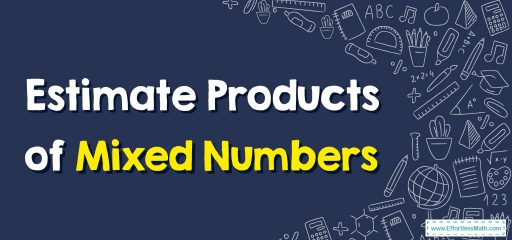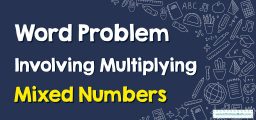How to Estimate Products of Mixed Numbers
In this article, you will learn how to estimate products of mixed numbers. Estimating the products of mixed numbers is an important skill that can be useful in a variety of real-world situations.

Mixed numbers are numbers that have a whole number part and a fractional part, and multiplying them can sometimes be challenging.
However, by following a few simple steps, you can learn to estimate the products of mixed numbers with ease.
A step-by-step guide to estimate products of mixed numbers
To begin, it is helpful to convert mixed numbers to improper fractions.
An improper fraction is a fraction in which the numerator is greater than or equal to the denominator.
To convert a mixed number to an improper fraction, you multiply the whole number by the denominator and then add the numerator.
The resulting sum is the numerator of the improper fraction, and the denominator stays the same.
Once you have converted the mixed numbers to improper fractions, you can multiply them together.
To estimate the product, you can round the fractions to the nearest whole number or use mental math to simplify the calculation.
For example, if you are multiplying 3 1/2 by 2 3/4, you could round 3 1/2 up to 4 and 2 3/4 down to 2. Then, you can multiply 4 by 2 to get 8, which is a reasonable estimate of the product.
Alternatively, you could use mental math to simplify the calculation.
For example, you could recognize that 3 1/2 is equal to 7/2 and 2 3/4 is equal to 11/4. Then, you could multiply 7 by 11 to get 77 and multiply 2 by 4 to get 8. Finally, you could simplify the fraction 77/8 to get 9 5/8, which is the exact product.
Estimate Products of Mixed Numbers – Example 1
Estimate the result by rounding each number to the nearest whole number. \(14 \frac{4}{5}×17 \frac{3}{4}=\)__?
Solution:
Step 1: \(14 \frac{4}{5}\) rounded to the nearest whole number is 15.
Step 2: \(17 \frac{3}{4}\) rounded to the nearest whole number is 18.
Step 3: Now, \(15×18=90\)
Estimate Products of Mixed Numbers – Example 2
Estimate the multiplication by rounding the first factor to the nearest whole number and the second factor to the nearest hundred. \(18×325 \frac{1}{4}=\)?
Step 1: 18 rounded to the nearest ten is 20.
Step 2: \(325 \frac{1}{4}\) rounded to the nearest one is 300.
Step 3: Now, \(20×300=6000\)
Related to This Article
More math articles
- 8th Grade TCAP Math Worksheets: FREE & Printable
- 7 Best Calculators for High School
- ALEKS Math Practice Test Questions
- Best Back-to-School Math Apps for Students
- How To Create a Distraction-Free Study Environment: 10 Tips
- How to Solve Real-Life Puzzles: Word Problems on Adding and Subtracting Fractions with Like Denominators
- The Ultimate PSAT Math Course (+FREE Worksheets & Tests)
- Addition of Four-Digit Numbers
- 10 Most Common 7th Grade SBAC Math Questions
- Top 10 OAR Math Practice Questions


























What people say about "How to Estimate Products of Mixed Numbers - Effortless Math: We Help Students Learn to LOVE Mathematics"?
No one replied yet.